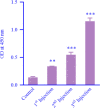Investigating the effect of cGRP78 vaccine against different cancer cells and its role in reducing melanoma metastasis
- PMID: 39006979
- PMCID: PMC11244710
- DOI: 10.4103/1735-5362.394822
Investigating the effect of cGRP78 vaccine against different cancer cells and its role in reducing melanoma metastasis
Abstract
Background and purpose: Treatment of malignancies with chemotherapy and surgery is often associated with disease recurrence and metastasis. Immunotherapy improves cancer treatment by creating an active response against tumor antigens. Various cancer cells express a large amount of glucose-regulated protein 78 (GRP78) protein on their surface. Stimulating the immune system against this antigen can expose cancer cells to the immune system. Herein, we investigated the effectiveness of a cGRP78-based vaccine against different cancer cells.
Experimental approach: BALB/c mice were immunized with the cGRP78. The humoral immune response against different cancer cells was assessed by Cell-ELISA. The cellular immunity response was determined by splenocyte proliferation assay with different cancer antigens. The effect of vaccination on metastasis was investigated in vaccinated mice by injecting melanoma cancer cells into the tail of mice.
Findings/results: These results indicated that the cGRP78 has acceptable antigenicity and stimulates the immune system to produce antibodies. After three injections, the amount of produced antibody was significantly different from the control group. Compared to the other three cell types, Hela and HepG2 showed the highest reaction to the serum of vaccinated mice. Cellular immunity against the B16F10 cell line had the best results compared to other cells. The metastasis results showed that after 30 days, the growth of B16F10 melanoma cancer cells was not noticeable in the lung tissue of vaccinated mice.
Conclusion and implications: Considering the resistance of vaccinated mice to metastasis, this vaccine offers a promising prospect for cancer treatment by inhibiting the spread of cancer cells.
Keywords: Immunotherapy.; Melanoma; Metastasis; cGRP78 vaccine.
Copyright: © 2024 Research in Pharmaceutical Sciences.
Conflict of interest statement
All authors declared no conflict of interest in this study.
Figures





Similar articles
-
Introduction of a new recombinant vaccine based on GRP78 for breast cancer immunotherapy and evaluation in a mouse model.Bioimpacts. 2024;14(2):27829. doi: 10.34172/bi.2023.27829. Epub 2023 Sep 18. Bioimpacts. 2024. PMID: 38505675 Free PMC article.
-
Effective tumor immunity to melanoma mediated by B16F10 cancer stem cell vaccine.Int Immunopharmacol. 2017 Nov;52:238-244. doi: 10.1016/j.intimp.2017.09.019. Epub 2017 Sep 23. Int Immunopharmacol. 2017. PMID: 28950176
-
[Preliminary study of the inhibitory effect and mechanism of B16F10-ESAT-6-gpi/IL-21 vaccine on the pulmonary metastasis in mouse models of melanoma].Zhonghua Zhong Liu Za Zhi. 2014 Apr;36(4):245-9. Zhonghua Zhong Liu Za Zhi. 2014. PMID: 24989908 Chinese.
-
Immune modulations during chemoimmunotherapy & novel vaccine strategies--in metastatic melanoma and non small-cell lung cancer.Dan Med J. 2013 Dec;60(12):B4774. Dan Med J. 2013. PMID: 24355457 Review.
-
Pulsing of dendritic cells with cell lysates from either B16 melanoma or MCA-106 fibrosarcoma yields equally effective vaccines against B16 tumors in mice.J Surg Oncol. 1998 Jun;68(2):79-91. doi: 10.1002/(sici)1096-9098(199806)68:2<79::aid-jso3>3.0.co;2-h. J Surg Oncol. 1998. PMID: 9624036 Review.
Cited by
-
Development of therapeutic cancer vaccines based on cancer immunity cycle.Front Med. 2025 Aug;19(4):553-599. doi: 10.1007/s11684-025-1134-6. Epub 2025 Jul 14. Front Med. 2025. PMID: 40653561 Review.
References
-
- Abbott M, Ustoyev Y. Cancer and the immune system: the history and background of immunotherapy. Semin Oncol Nurs. 2019;35(5):1–5. 150923. DOI: 10.1016/j.soncn.2019.08.002. - PubMed
-
- Josephs DH, Bax HJ, Karagiannis SN. Tumour-associated macrophage polarisation and re-education with immunotherapy. Front Biosci (Elite Ed) 2015;7(2):293–308. DOI: 10.2741/E735. - PubMed
-
- Soliman H. Developing an effective breast cancer vaccine. Cancer Control. 2010;17(3):183–190. DOI: 10.1177/107327481001700307. - PubMed
LinkOut - more resources
Full Text Sources
Miscellaneous
